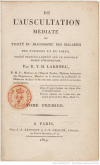The first 200 years of cardiac auscultation and future perspectives
- PMID: 30881010
- PMCID: PMC6408918
- DOI: 10.2147/JMDH.S193904
The first 200 years of cardiac auscultation and future perspectives
Abstract
Cardiac auscultation - even with its limitations - is still a valid and economical technique for the diagnosis of cardiovascular diseases, and despite the growing demand for sophisticated imaging techniques, clinical use of the stethoscope in medical practice has not yet been abandoned. In 1816, René-Théophile-Hyacinthe Laënnec invented the stethoscope, while examining a young woman with suspected heart disease, giving rise to mediated auscultation. He described in detail several heart and lung sounds, correlating them with postmortem pathology. Even today, a correct interpretation of heart sounds, integrated with the clinical history and physical examination, allows to detect properly most of the structural heart abnormalities or to evaluate them in a differential diagnosis. However, the lack of organic teaching of auscultation and its inadequate practice have a negative impact on the clinical competence of physicians in training, also reflecting a diminished academic interest in physical semiotic. Medical simulation could be an effective instructional tool in teaching and deepening auscultation. Handheld ultrasound devices could be used for screening or for integrating and improving auscultatory abilities of physicians; the electronic stethoscope, with its new digital capabilities, will help to achieve a correct diagnosis. The availability of innovative representations of the sounds with phono- and spectrograms provides an important aid in diagnosis, in teaching practice and pedagogy. Technological innovations, despite their undoubted value, must complement and not supplant a complete physical examination; clinical auscultation remains an important and cost-effective screening method for the physicians in cardiorespiratory diagnosis. Cardiac auscultation has a future, and the stethoscope has not yet become a medical heirloom.
Keywords: auscultation; cardiac physical examination; medical history; medical sciences; stethoscope.
Conflict of interest statement
Disclosure The authors report no conflicts of interest in this work.
Figures


Similar articles
-
Rene Theophile Hyacinthe Laënnec (1781-1826): the man behind the stethoscope.Clin Med Res. 2006 Sep;4(3):230-5. doi: 10.3121/cmr.4.3.230. Clin Med Res. 2006. PMID: 17048358 Free PMC article.
-
Bedside cardiac examination: constancy in a sea of change.Curr Probl Cardiol. 2000 Nov;25(11):783-825. doi: 10.1067/mcd.2000.109835. Curr Probl Cardiol. 2000. PMID: 11082789 Review.
-
René Théophile Hyacinthe Laënnec (1781-1826). Two hundred years of the stethoscope. A brief overview.Arch Argent Pediatr. 2020 Oct;118(5):e444-e448. doi: 10.5546/aap.2020.eng.e444. Arch Argent Pediatr. 2020. PMID: 32924399 English, Spanish.
-
Celebrating Two Centuries since the Invention of the Stethoscope. René Théophile Hyacinthe Laënnec (1781-1826).Ann Am Thorac Soc. 2016 Oct;13(10):1667-1670. doi: 10.1513/AnnalsATS.201605-411PS. Ann Am Thorac Soc. 2016. PMID: 27467020
-
The 200th anniversary of the stethoscope: Can this low-tech device survive in the high-tech 21st century?Eur Heart J. 2016 Dec 14;37(47):3536-3543. doi: 10.1093/eurheartj/ehw034. Epub 2016 Feb 22. Eur Heart J. 2016. PMID: 26908946 Review.
Cited by
-
Connecting the dots: Bridging virtual to in-person physical assessment.Teach Learn Nurs. 2022 Jan;17(1):147-150. doi: 10.1016/j.teln.2021.08.002. Epub 2021 Sep 14. Teach Learn Nurs. 2022. PMID: 35035318 Free PMC article.
-
Diagnostic Accuracy of AI Algorithms in Aortic Stenosis Screening: A Systematic Review and Meta-Analysis.Clin Med Res. 2024 Sep;22(3):145-155. doi: 10.3121/cmr.2024.1934. Clin Med Res. 2024. PMID: 39438148 Free PMC article.
-
Implementation of stethoscope disinfection: an observational study on nursing staff practice and knowledge.GMS Hyg Infect Control. 2024 May 17;19:Doc30. doi: 10.3205/dgkh000485. eCollection 2024. GMS Hyg Infect Control. 2024. PMID: 38883408 Free PMC article.
-
A novel wearable device integrating ECG and PCG for cardiac health monitoring.Microsyst Nanoeng. 2025 Jan 15;11(1):7. doi: 10.1038/s41378-024-00858-3. Microsyst Nanoeng. 2025. PMID: 39814701 Free PMC article.
-
A case presented with fever enlightened by cardiac auscultation: Sarcoma originated in pulmonary artery.Turk J Emerg Med. 2024 Jan 8;24(1):55-57. doi: 10.4103/tjem.tjem_358_22. eCollection 2024 Jan-Mar. Turk J Emerg Med. 2024. PMID: 38343518 Free PMC article.
References
-
- Laënnec RTH. De l’auscultation médiate ou Traité du Diagnostic des Maladies des Poumons et du Coeur. Paris: Chaude; 1819. (A treatise on the diseases of the chest and on mediate auscultation). French.
-
- Mangione S, Nieman LZ, Gracely E, Kaye D. The teaching and practice of cardiac auscultation during internal medicine and cardiology training: a nationwide survey. Ann Intern Med. 1993;119(1):47–54. - PubMed
-
- Mangione S, Nieman LZ. Cardiac auscultatory skills of internal medicine and family practice trainees. A comparison of diagnostic proficiency. JAMA. 1997;278(9):717–722. - PubMed
-
- Littré E. Oeuvres Complètes D’Hippocrate. Vol. 7. Paris: J. B. Baillère; 1851. (Hippocrates’s Complete Works). French.
Publication types
LinkOut - more resources
Full Text Sources

